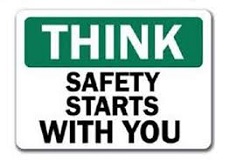
Did you know that in the United States, a worker is injured on the job once every seven seconds? That adds up to 12,300 injuries each day, or a staggering 4,500,000 every year.
As a small business owner, you owe your employees a safe working environment. Not only will maintaining a safe workplace lower the odds that you will have to pay out workers compensation claims, but it’s just the right thing to do.
First: Who is Most at Risk?
What occupations do you think are most at risk for on-the-job injuries or accidents? If you guessed construction workers, first responders such as police and firefighters, and manufacturing, you’re not wrong — those are three of the most vulnerable professions.
However, it might surprise you to learn that overexertion, including repetitive stress injuries, accounts for fully one-third of all workplace injuries. So it’s not just the folks who are putting their lives on the line each day, or engaged in strenuous physical labor, who are at risk. Office workers and other white-collar employees are also prone to getting hurt on the job.
Safety Starts Right from the Get-Go
It’s important to provide a safe environment from Day One. One aspect of doing so is hiring employees who are physically capable of performing their work duties. When you advertise positions and begin the hiring process, be certain to indicate the physical requirements — for example, lifting up to 50 lbs. or standing for an entire shift.
In some cases, it’s a good idea to require potential employees to pass a physical examination. (And if you own a private company with 15 or more employees, it’s the law.) The qualities that will be tested include strength, balance, endurance, cardiovascular health, stamina, flexibility, and more.
Upon hire, all employees should receive a copy of the company’s safety policy and procedures. These should also be posted on a bulletin board in a common area of the office, such as the break room.
Providing Proper Safety Equipment
Standards set by the Occupational Safety and Health Administration (OSHA) regulate the use of personal protective equipment (PPE) on the job. Depending on the industry, such equipment might include:
- Goggles or eye protection
- Hard hats or helmets
- High-visibility clothing
- Earplugs or earmuffs
- Disposable gloves
- Coveralls
- Face shields
- Harness and fall-arrest devices
- Foot protection such as steel-toed boots or non-skid shoes
In most cases, you as the employer are required to provide (read: pay for) any items your workers need to comply with OSHA standards. Again, it’s also the decent thing to do.
For office workers, an evaluation of the workspace from an ergonomic perspective is key to safety. Adjustable chairs, work surfaces, and computer monitors may seem costly, but they can go a long way toward preventing even costlier disability or workers’ comp claims. Be sure to train employees on how to adjust these items. If necessary, hire a consultant who is trained in ergonomics — or seek out training for the office manager or HR rep, who can in turn advise all employees.
In the Event of an Accident or Injury
In the unfortunate event of an on-the-job accident or injury, there are procedures that should be followed. The steps to take should be clearly outlined in your posted safety policy, and reviewed with employees during initial onboarding and then once yearly thereafter.
It is your responsibility as an employer to provide immediate medical attention when an employee is injured. In addition, injuries should be documented and reported to the local workers’ compensation board.
The process of administering workers’ comp benefits can be fraught with disagreements and legal pitfalls. Savvy business owners will make sure that they are in compliance with workers’ compensation and disability requirements at all times. That way, they are protected in the event that an injured employee retains a workers compensation lawyer and begins legal proceedings against the company.
After the Employee Is Cleared to Return to Work
Your responsibility doesn’t end when the employee receives medical attention or has her workers’ compensation claim fulfilled. Upon an employee’s clearance to return to work, you have a duty to accommodate her by offering vocational rehabilitation, physical alterations of her workspace, or a change in work duties or assignment.
In other words, you should be ready to welcome your employee back to the office or workplace with open arms, and to do whatever it takes to help her get back up to speed. That may mean offering a different job, retraining her, or providing accommodations in the workplace.
Wrapping Up
As a small business owner, you wear a lot of hats and work hard to keep a number of plates spinning. Dealing with workplace safety and compliance with workers’ compensation regulations may not seem as important as, say, meeting client deadlines or approving payroll. However, they are imperative — for the safety and security of both your workers and your business’s good name.






